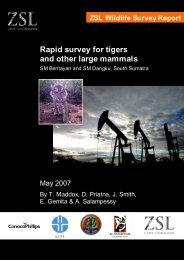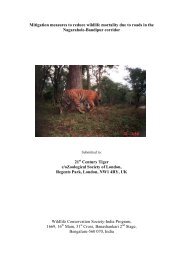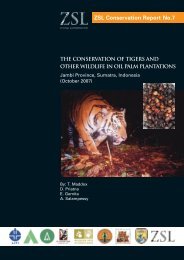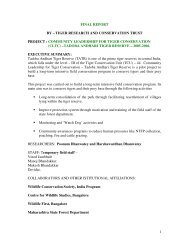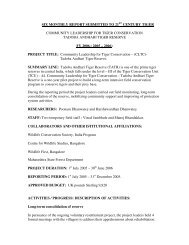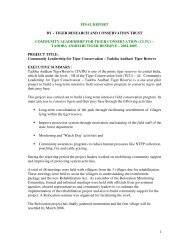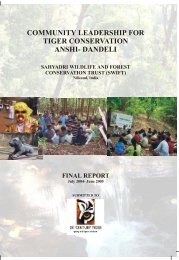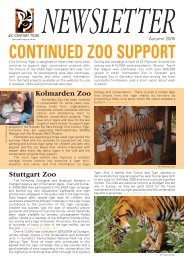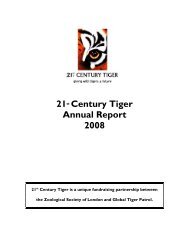WCS long term research final report 2006 - 21st Century Tiger
WCS long term research final report 2006 - 21st Century Tiger
WCS long term research final report 2006 - 21st Century Tiger
Create successful ePaper yourself
Turn your PDF publications into a flip-book with our unique Google optimized e-Paper software.
Project Coordinators: Dale Miquelle, Ph.D.<br />
John Goodrich, Ph.D.<br />
Reporting Period: 1 July 2005 – 30 June <strong>2006</strong><br />
Contacts:<br />
Colin Poole<br />
Director<br />
Asia Program<br />
Wildlife Conservation Society<br />
2300 Southern Boulevard<br />
Bronx, NY 10460<br />
T: 718.741.5885<br />
F: 718.364.4275<br />
E: cpoole@wcs.org<br />
Linde E. T. Ostro, Ph.D.<br />
Director<br />
Foundation Relations<br />
Wildlife Conservation Society<br />
2300 Southern Boulevard<br />
Bronx, NY 10460<br />
T: 718.741.1653<br />
F: 718.364.7963<br />
E: lostro@wcs.org
The Amur or Siberian tiger (Panthera tigris altaica) is a classic landscape species, ranging<br />
across a variety of human-influenced landscapes, and competing with people for critical<br />
habitat and resources. Their population has been at perilously low levels, and in the Russian<br />
Far East (RFE) international efforts to save them from extinction have been ongoing for more<br />
than a decade. In recent years—partly due to <strong>WCS</strong>’s 13-year-<strong>long</strong> efforts—the tiger has<br />
begun to show signs of recovery. Poaching has declined, and improved scientific<br />
understanding of the species’ requirements has enabled planners to take actions including: 1)<br />
protected area planning and management; 2) establishment of protected areas in China; 3)<br />
establishment of a legal basis for corridors between protected areas; 4) road closures to<br />
reduce mortality of tigers and their prey; 5) management of game populations outside<br />
protected areas to benefit both humans and tigers; 6) education and outreach to ensure a local<br />
understanding of the role tigers play in the ecosystem; 7) bi-lateral discussions to establish<br />
transboundary reserves to connect tiger populations in the RFE and northeast China; and 8)<br />
efforts to reestablish viable tiger populations in China. However, despite 13 years of<br />
<strong>research</strong>, there are at least five key reasons why we feel the Siberian <strong>Tiger</strong> Project (STP)<br />
must continue.<br />
1. Data are lacking in several areas (e.g., cub survival and causes of cub mortality, dispersal,<br />
and predation rates). These data have proven extremely difficult to obtain. While<br />
significant progress has been made in recent years, continuing efforts are necessary to<br />
complete our understanding of these key features of tiger biology.<br />
2. Long-<strong>term</strong> radio telemetry and monitoring studies provide invaluable insights into tiger<br />
ecology and conservation that cannot be derived from short-<strong>term</strong> studies. For instance,<br />
results from 2004 suggest that when tigers are well protected from poaching not only do<br />
survivorship and reproduction increase, but density of adult females may also increase by<br />
as much as 100%. Further monitoring is needed to de<strong>term</strong>ine if the system can support the<br />
current high densities and reproduction in our core study area.<br />
3. We are formalizing and expanding our efforts to prepare the next generation of<br />
conservation biologists in the RFE, as well as international conservation biologists, using<br />
the STP as a vehicle for intensive field training and as an introduction to the problems of<br />
international conservation efforts. This includes the construction of the Sikhote-Alin<br />
Research Center.<br />
4. Inspection <strong>Tiger</strong> (Ministry of Natural Resources, Russian Federation) relies on our skilled<br />
staff to assist with tiger-human conflicts. Despite continuing efforts to train Inspection<br />
<strong>Tiger</strong> staff, turnover and inconsistencies in the organization have limited their capacity to<br />
become self-sufficient.<br />
5. Results of our <strong>research</strong> demonstrate our competence as biologists, and provide a strong<br />
platform for making conservation recommendations. As a conservation entity in the RFE,<br />
<strong>WCS</strong> is unique in that our work is science-based. This gives us a powerful position in<br />
discussions of conservation questions, because we are the only organization with such a<br />
wealth of knowledge and understanding of tiger ecology. The continuation of the STP is<br />
critical to maintaining our position as a leader in the conservation community here and<br />
enables us to ensure that science-based recommendations are included in the dialog on<br />
how to proceed with tiger conservation in Russia.<br />
2
Research Program:<br />
The goal of our <strong>research</strong> program is to collect the best scientifically-based data possible<br />
for use in conservation plans. A second goal is to train the next generation of Russian<br />
tiger conservation biologists. Specific objectives for this year include:<br />
• Monitor cubs (two litters expected) to de<strong>term</strong>ine survival rates, and sub-adults<br />
(two collared) to de<strong>term</strong>ine dispersal movements.<br />
• Monitor tigers in our core study area to de<strong>term</strong>ine if recent increase in density and<br />
reproductive output is sustainable.<br />
• Collect at least six month-<strong>long</strong> predation sequences.<br />
• Develop plans for a camera trapping study in Sikhote-Alin Zapovednik, secure<br />
funding for acquisition of equipment, and identify students to initiate this<br />
program.<br />
• Complete construction of housing and office for graduate students, continue<br />
training students currently conducting <strong>research</strong> on the project, and search for new<br />
students.<br />
<strong>Tiger</strong>-Human Conflicts:<br />
• Continue assisting Inspection <strong>Tiger</strong> with<br />
tiger human conflict situations as the<br />
need arises, conduct the necessary<br />
intervention, and monitor the outcomes.<br />
• Continue the ongoing field training of<br />
members of the <strong>Tiger</strong> Response Team.<br />
Field Study<br />
Capture activities. On 11 October 2005, we<br />
captured three six-week-old cubs (Pt72, Pt73,<br />
and Pt74) that were born to Pt35 in September<br />
to de<strong>term</strong>ine causes of mortality of young cubs<br />
(Photo 1). We captured the cubs by hand and<br />
handled them without anesthesia. We fitted<br />
them with collars designed to expand to 49 cm<br />
(large enough for an adult female) and break off<br />
within one year. Pt35 was captured as an adult<br />
when she immigrated to the study area in 1999<br />
and this was the forth litter she had produced<br />
since that time. We will attempt to recapture<br />
Photo 1. Nikolai Rybin labels a sample<br />
container while holding one of Pt35’s<br />
cubs, which was just fitted with a radiocollar.<br />
Photo by J. Goodrich/<strong>WCS</strong>.<br />
3
Photo 2. Vladimir Melnicov (right) and Nikolai<br />
Rybin measure Pt35 after she was captured via<br />
helicopter.<br />
Cub survival: To estimate cub survival rates<br />
and de<strong>term</strong>ine causes of mortality, we<br />
monitored a litter of three cubs born to Pt56 in<br />
July 2004 and fitted collars on three cubs born<br />
to Pt35 in September 2005 (Table 1). We<br />
successfully monitored Pt56’s litter through<br />
their first year of life, although two of the<br />
three transmitters failed seven to ten months<br />
after implementation (likely because siblings<br />
chewed on them). Nonetheless, we<br />
documented that all three were alive at one<br />
year of age. In October 2005, we captured<br />
and collared three five-week-old cubs born to<br />
Pt35 (photo 1). However, over the course of<br />
two months, all three cubs chewed each<br />
other’s collars off. It is unclear why this<br />
happened with Pt35’s litter but not that of<br />
Pt56, but we believe that Pt35’s cubs were<br />
simply more healthy and hence, more playful.<br />
these cubs in autumn <strong>2006</strong> to fit them<br />
with permanent collars.<br />
On 28 October, we captured tiger<br />
Pt75, the 15.5-month-old daughter of<br />
Pt56. This cub was originally collared<br />
in August 2004 when it was five weeks<br />
old. At that time, three cubs were<br />
captured (Pt66, Pt67, Pt68), but it was<br />
unclear which of these cubs was Pt75<br />
because she had slipped her collar.<br />
However, genetic analysis will later<br />
de<strong>term</strong>ine her identity. Together with<br />
Pt75, we recaptured Pt56 and changed<br />
her radio-collar because the batteries<br />
were due to fail.<br />
We recaptured Pt35 via<br />
helicopter in April <strong>2006</strong> to change her<br />
radiocollar (Photo 2). She was in very<br />
good physical condition, despite old age<br />
(estimated 13-14), broken teeth (photo<br />
3), and having raised three cubs through<br />
the winter. We also attempted to<br />
recapture Pt55, via helicopter and with<br />
snares, but she so far has avoided our<br />
efforts. We intend to fit this tigress with<br />
a GPS collar if and when we capture her.<br />
Photo 3. Despite three broken canines,<br />
Pt35 was in very good condition.<br />
4
We documented through tracks and visual sightings that all three cubs were alive in late<br />
June <strong>2006</strong>.<br />
Subadult monitoring: We monitored three subadults, Pt64, Pt69, and Pt75, during the<br />
<strong>report</strong> period. All were born to radio-collared tigresses (Pt64 and Pt69 were Pt35’s cubs<br />
and Pt71 was Pt56’s cub). Pt64 dispersed north about 95 km from his natal home range<br />
when he was just over two years old, and at least temporarily settled a<strong>long</strong> the Kema<br />
River. This was the oldest dispersal age recorded on the Siberian <strong>Tiger</strong> Project. He was<br />
fitted with an expandable break-away collar when captured because he was too small for<br />
an adult sized collar. His collar broke away (fell off) in March of <strong>2006</strong>. Pt69 began<br />
dispersing to the west when he was about 22 months old, but then returned to his natal<br />
home range where, in July 2005, he was poached a<strong>long</strong> the main road that passes through<br />
the zapovednik. Pt71, the second dispersing female monitored on the Project, began<br />
dispersing in February <strong>2006</strong>. She moved primarily to the south and was located as far as<br />
35 km from her natal home range. In May <strong>2006</strong>, the tone of the signal from her<br />
radiocollar changed dramatically, suggesting a transmitter malfunction. A month later,<br />
we lost contact with her signal and assume that her radio-collar failed.<br />
Monitoring of resident adults in our core area: In July 2004, we monitored an<br />
unexpected event that may provide some of the most important data we have collected<br />
during the course of the project. Two tigresses (Pt55 and Pt56) captured as cubs in 2001<br />
and who settled in their natal home ranges, gave birth to their first litters of cubs. Pt56<br />
was just three years old and Pt55 was just under three when they gave birth, i.e., they<br />
gave birth at a very young age. This marked a very important change in the tiger<br />
population in our core study area, i.e., the density of adult tigresses doubled, and all four<br />
of the resident tigresses had cubs. This change was likely made possible by social<br />
stability created by a <strong>long</strong> (about five years) period during which human-induced<br />
mortality was eliminated in our core study area. That is, when resident adults survive<br />
<strong>long</strong> enough, densities may increase dramatically as their offspring settle in their natal<br />
home ranges. It has now been two years since the change in density and it appears that<br />
the situation is stable. These data have strong implications for conservation, suggesting<br />
that when well protected, adult female densities may reach levels two times greater than<br />
previously believed. During the <strong>report</strong> period, all four resident adults in our core area<br />
were with cubs and territory boundaries appeared stable two years after the devisions<br />
between mothers and daughters.<br />
Predation sequences: We purchased two GPS collars and are attempting to capture tigers<br />
Pt56 and Pt60 to fit them with the collars. We were unable to capture either tiger via<br />
helicopter in winter <strong>2006</strong>. We will conduct capture work on the ground in autumn <strong>2006</strong><br />
and from the air in the winter. Work on predation sequences will continue once we have<br />
tigers fitted with GPS collars.<br />
5
<strong>Tiger</strong><br />
no.<br />
Table 1. Summary of radio-tracking data collected from tigers on the Sikhote-Alin<br />
Biosphere Zapovednik.<br />
Dates tracked Number locations<br />
Days<br />
tracked total<br />
Report<br />
period<br />
Sex Age From To<br />
Notes<br />
3 cubs born early<br />
35 F 12 10/21/1999 6/30/<strong>2006</strong> 2444 1810 235 Sept. 2005.<br />
37 F 12 11/17/1999 6/30/<strong>2006</strong> 2417 424 38<br />
49 M 8 5/22/2001 6/30/<strong>2006</strong> 1865 496 67<br />
55 F 4 10/24/2002 6/30/<strong>2006</strong> 1345 259 66 Pt37's daughter.<br />
56 F 4 10/24/2002 6/30/<strong>2006</strong> 1345 462 122 Pt35's daughter.<br />
60 M 5 8/8/2003 6/30/<strong>2006</strong> 511 55 15<br />
64 M 2 5/24/2004 3/1/<strong>2006</strong> 646 240 31 Pt35's son.<br />
69 M 1.3 9/16/2004 7/29/2005 316 152 1 Pt35's son. Poached.<br />
Pt35's daughter.<br />
72 F 0.12 10/11/2005 11/6/2005 26 12 12 Slipped collar.<br />
73 F 0.12 10/11/2005 12/14/2005 64 42 42 Pt35's daughter.<br />
74 F 0.12 10/11/2005 12/11/2005 61 35 35 Pt35's daughter.<br />
Pt56's daughter.<br />
75 F 1.3 10/28/2005 6/30/<strong>2006</strong> 245 34 34 Collar failed?<br />
Camera trapping. In April <strong>2006</strong>, we began a new study to compare techniques for<br />
estimating tiger densities. The study will focus on camera trapping, but will likely also<br />
incorporate hair snagging to collect DNA samples and identification of individuals based<br />
on digital photos of tracks. We are conducting this work as a graduate student project.<br />
Svetlana Sutyrina, a graduate student from the University of Irkutsk, is leading this study<br />
and we are currently searching for a non-Russian student to work with her.<br />
Graduate student program: Construction of our office and housing is well underway<br />
(photo 4) and we hope to complete construction in <strong>2006</strong>. We will continue our search for<br />
graduate students when the building nears completion.<br />
6
Photo 4. Office and graduate student housing under construction in Terney, September 2005. Photo by<br />
J. Goodrich/<strong>WCS</strong>.<br />
<strong>Tiger</strong>-Human Conflicts<br />
Conflict situations. We dealt with three conflict situations during the <strong>report</strong> period:<br />
1. In December 2005, Utyos Wildlife Rehabilitation Center in Khabarovski Krai<br />
requested our assistance to anesthetize and evaluate the health of a tiger cub. The cub<br />
had been taken into captivity one year ago after it had been shot in the face by a poacher<br />
(see <strong>final</strong> <strong>report</strong> 2005). At that time, the cub underwent an operation to treat its wound<br />
and wire its shattered jaw. One year later, the cub’s wounds had healed well, although<br />
the jaw was slightly crooked and several teeth were missing. The cub was also very tame<br />
after a year in captivity and intensive care. Thus, we declared the cub unfit for release<br />
into the wild and it was later sent to a zoo in Khabarovsk.<br />
2. In January <strong>2006</strong>, Inspection <strong>Tiger</strong> requested our assistance with a tigress with a<br />
cub that had been killing dogs in and near the town of Chornigovka in southwestern<br />
Primorski Krai. The tigress was traveling with a five-to-six month old cub. Her behavior<br />
was extremely bold - on several occasions, tracks indicated that she walked the streets of<br />
the town of Chornigovka, hunting dogs, with her cub. Although no aggressive<br />
encounters were <strong>report</strong>ed, it was likely only a matter of time before she encountered a<br />
7
person at close range, in which case she would likely aggressively protect her cub.<br />
Hazing the tigress was ineffective because she killed dogs unpredictably over a large area<br />
in three different towns and surrounding farms. However, because she was with a cub,<br />
translocation was also out of the question. Thus, it was decided to capture the tigress, fit<br />
her with a radio-collar and monitor her intensively, using pyrotechnics to frighten her<br />
when she approached human habitations. The tigress was captured on 24 January and<br />
was surprisingly in good physical condition. We estimated her age to be 11-14 years old<br />
based on very worn and stained teeth.<br />
A team of two people (one from Inspection <strong>Tiger</strong> and one from <strong>WCS</strong>)<br />
immediately began intensive monitoring. The intension was to at best, through negative<br />
conditioning, teach the tigress and cub to avoid preying on domestic animals, or at worst,<br />
prevent the pair from preying on domestic animals until the cub became independent and<br />
the mother could be translocated. Prey densities were extremely low in the area so in<br />
addition to negative conditioning, the pair was fed sika deer on three occasions. The deer<br />
were placed in the forest in close proximity to the tigress and far from human habitations.<br />
Every attempt was made to reduce the amount of human scent and tracks at the feeding<br />
site. <strong>WCS</strong> personnel worked with Inspection <strong>Tiger</strong> for approximately one month to train<br />
their personnel in radiotelemetry techniques. We then loaned Inspection <strong>Tiger</strong> a<br />
telemetry receiver and antenna so that they could continue monitoring.<br />
The pair was hazed with rockets from farms on five occasions. The immediate<br />
effect was that they left the area, but there was little apparent <strong>long</strong>-<strong>term</strong> effect, i.e., the<br />
depredations continued through the winter. This was likely, in part, because there was<br />
little wild prey in the area. At the time of this writing, Inspection <strong>Tiger</strong> <strong>report</strong>ed that they<br />
had not heard a signal for over two months, but admitted that they had monitored<br />
infrequently. Reports from locals suggested that the tigress was still in the area, but<br />
depredations had ceased, perhaps because small prey animals such as badgers and<br />
raccoon dogs become available in summer.<br />
This was a difficult situation with no good solution because of the presence of the<br />
cub. The tigress’s behavior was extremely bold and local people were very upset. Our<br />
course of action was expensive, labor intensive, and while it likely prevented a number of<br />
depredations, ultimately it did not seem to change her behavior. However, with wild prey<br />
nearly non-existent in the area, the tigress had little choice but to prey on domestic<br />
animals. Our presence did alleviate local concerns and, through discussions with local<br />
people, officials, and press, brought to light the problems associated with heavy poaching<br />
of prey in the area.<br />
3. On 9 March <strong>2006</strong>, <strong>WCS</strong> received a <strong>report</strong> of two emaciated tiger cubs at a<br />
logging camp about 50 km north of Terney. Nikolai Rybin and Vladimir Melnicov<br />
responded to the scene (both Miquelle and Goodrich were out of the country). They<br />
found two emaciated tiger cubs that were about five months old. The cubs were weak<br />
enough so that they captured the cubs by hand and transported them to Terney in the cab<br />
of a pick-up truck. We held the cubs for four days, during which time the condition of<br />
one rapidly improved while the condition of the other deteriorated. Inspection <strong>Tiger</strong><br />
collected the cubs and transported them to Vladivostok, where presumably they would<br />
receive veterinary treatment. The weaker cub died en route to Vladivostok. The<br />
remaining cub was sent to a zoo.<br />
8
Inspection <strong>Tiger</strong>. The Ministry of Natural Resources underwent reorganization in 2004,<br />
resulting in considerable changes. A significant change relative to our work with tigerhuman<br />
conflicts was that Boris Litveenov no <strong>long</strong>er heads the <strong>Tiger</strong> Response Team.<br />
Indeed, all Inspection <strong>Tiger</strong> personnel that have received significant training from <strong>WCS</strong><br />
have left Inspection <strong>Tiger</strong>. Additionally, apparently all crates used for transporting tigers<br />
were lost in the reorganization. Thus, our assistance with tiger-human conflict situations<br />
has become more important. In the future, we intend to continue assisting with conflict<br />
situations and will continue training Inspection <strong>Tiger</strong> personnel to deal with tiger-human<br />
conflicts.<br />
During the <strong>report</strong> period we published the Russian-language monograph, <strong>Tiger</strong>s of<br />
Sikhote-Alin Zapovednik: Ecology and Conservation. The monograph includes 26<br />
chapters with detailed analyses of data collected from 1992-2004 on tiger ecology and<br />
conservation, prey and competitor relationships, and tiger-human conflict issues.<br />
Selected chapters are included in the following bibliography.<br />
Scientific<br />
Goodrich, J. M. and D. G. Miquelle. 2005. Translocation of problem Amur tigers to<br />
alleviate tiger-human conflicts. Oryx 39:1-4.<br />
Goodrich, J. M., K. S. Quigley, D. G. Miquelle, E. N. Smirnov, L. L. Kerley, H. B.<br />
Quigley, M. G. Hornocker, and D. Armstrong. 2005. Blood chemistry and<br />
infectious diseases of Amur tigers. Pages 43-49 in Miquelle, D. G., E. N.<br />
Smirnov, and J. M. Goodrich, editors. <strong>Tiger</strong>s of Sikhote-Alin Zapovednik:<br />
ecology and conservation. PSP, Vladivostok, Russia. 224 pp. (in Russian).<br />
Goodrich, J. M., L. L. Kerley, E. N. Smirnov, D. G. Miquelle, B. O. Schleyer, L.<br />
McDonald, T. L. McDonald. 2005. Survival Rates and Causes of Mortality of<br />
Amur <strong>Tiger</strong>s on and near the Sikhote-Alin Biosphere Zapovednik. Pages 69-75 in<br />
Miquelle, D. G., E. N. Smirnov, and J. M. Goodrich, editors, <strong>Tiger</strong>s of Sikhote-<br />
Alin Zapovednik: ecology and conservation. PSP, Vladivostok, Russia. 224 pp.<br />
(in Russian).<br />
Goodrich, J. M., L. L. Kerley, D. G. Miquelle, E. N. Smirnov, H. B. Quigley, M. G.<br />
Hornocker. 2005. Social structure of Amur tigers on Sikhote-Alin Biosphere<br />
Zapovednik. Pages 50-60 in Miquelle, D. G., E. N. Smirnov, and J. M. Goodrich,<br />
editors, <strong>Tiger</strong>s of Sikhote-Alin Zapovednik: ecology and conservation. PSP,<br />
Vladivostok, Russia. 224 pp. (in Russian).<br />
Goodrich, J. M., D. G. Miquelle, L. L. Kerley, E. N. Smirnov, H. B. Quigley, and M. G.<br />
Hornocker. 2005. Social Structure of the Amur <strong>Tiger</strong> Population on Sikhote-Alin<br />
Biosphere Zapovednik: Effects of Human-Induced Mortality and Implications for<br />
Social Regulation of Density. Pages 161-169 in E. V. Potikha, editor, Results of<br />
Protection and Research of the Sikhote-Alin Natural Landscape.<br />
Primpoligraphkombinat, Vladivostok, Russia. 516 pp. (In Russian with English<br />
summaries.)<br />
9
Goodrich, J. M. and D. G. Miquelle. 2005. <strong>Tiger</strong> Research on the Sikhote-Alin<br />
Biosphere Zapovednik: Importance and Application of Scientific Research to<br />
<strong>Tiger</strong> Conservation. Pages 153-161 in E. V. Potikha, editor, Results of<br />
Protection and Research of the Sikhote-Alin Natural Landscape.<br />
Primpoligraphkombinat, Vladivostok, Russia. 516 pp. (In Russian with English<br />
summaries).<br />
Miquelle, D. G., L. L. Kerley, J. M. Goodrich, B. O. Schleyer, E. N. Smirnov, H. B.<br />
Quigley, M. G. Hornocker, I. G. Nikolaev, and E. N. Matyushkin. 2005. Food<br />
habits and conservation of Amur tigers on Sikhote-Alin Zapovednik and the<br />
Russian Far East. 2005. Pages 125-131 in Miquelle, D. G., E. N. Smirnov, and J.<br />
M. Goodrich, editors, <strong>Tiger</strong>s of Sikhote-Alin Zapovednik: ecology and<br />
conservation. PSP, Vladivostok, Russia. 224 pp. (in Russian).<br />
Miquelle, D. G., P. A. Stevens, E. N. Smirnov, J. M. Goodrich, O. J. Zaumyslava, and A.<br />
E. Myslenkov. 2005. Competitive exclusion, functional redundancy, and<br />
conservation implications: tigers and wolves in the Russian Far East. Pages 179-<br />
207 in Ray, J., J. Berger, K. Redford, & Steneck (eds.). Large Carnivores and the<br />
Conservation of Biodiversity. Island Press.<br />
Miquelle, D.G., I. G. Nikolaev, J. Goodrich, B. Litvinov, E. N. Smirnov, and E. Suvorov.<br />
2005. Searching for the Co-Existence Recipe: A Case Study Of Conflicts<br />
Between People And <strong>Tiger</strong>s In The Russian Far East. Pages 305-322 in<br />
Woodruffe, R., and S. Thirgood (eds.). People and wildlife: conflict or coexistence?<br />
Cambridge University Press.<br />
Miquelle, D. G., E. N. Smirnov, and J. M. Goodrich, editors. 2005. <strong>Tiger</strong>s of Sikhote-<br />
Alin Zapovednik: ecology and conservation. PSP, Vladivostok, Russia. 224 pp.<br />
(in Russian).<br />
Miquelle, D.G., J. M. Goodrich, B. I. Litvinov, I. G. Nikolaev, E. N. Smirnov, E.<br />
Suvorov, and Y. A. Darmin. 2005. Searching for the Co-Existence Recipe: A<br />
Case Study Of Conflicts Between People And <strong>Tiger</strong>s In The Russian Far East.<br />
Pages 179-186 in Miquelle, D. G., E. N. Smirnov, and J. M. Goodrich, editors,<br />
<strong>Tiger</strong>s of Sikhote-Alin Zapovednik: ecology and conservation. PSP, Vladivostok,<br />
Russia. 224 pp. (in Russian).<br />
Seryodkin, I. V., J. M. Goodrich, A. V. Kostyrya, E. N. Smirnov, and D. G. Miquelle.<br />
2005. Food relationships between tigers and bears in Sikhote-Alin Reserve.<br />
Pages 309-312 in E. V. Potikha, editor, Results of Protection and Research of the<br />
Sikhote-Alin Natural Landscape. Primpoligraphkombinat, Vladivostok, Russia.<br />
516 pp. (In Russian with English summaries).<br />
Seryodkin, I. V., J. M. Goodrich, A. V. Kostyrya, B. O. Schleyer, E. N. Smirnov, L. L.<br />
Kerley, and D. G. Miquelle. 2005. Relationship between tigers, brown bears, and<br />
Himalayan black bears. Pages 156-163 in Miquelle, D. G., E. N. Smirnov, and J.<br />
Goodrich, editors, <strong>Tiger</strong>s of Sikhote-Alin Zapovednik: ecology and conservation.<br />
PSP, Vladivostok, Russia. 224 pp. (in Russian).<br />
Slaght, J. C., D. G. Miquelle, I. G. Nikolaev, J. M. Goodrich, E. N. Smirnov, K. Traylor-<br />
Holzer, S. Christie, T. Arjanova, J. L. D. Smith, and K. U. Karanth. 2005. Who‘s<br />
king of the beasts? Historical and recent body weights of wild and captive Amur<br />
tigers, with comparisons to other subspecies. Pages 25-35 in Miquelle, D. G., E.<br />
Smirnov, and J. M. Goodrich, editors, <strong>Tiger</strong>s of Sikhote-Alin Zapovednik:<br />
10
Popular<br />
ecology and conservation. PSP, Vladivostok, Russia. 224 pp. (in Russian).<br />
Goodrich, J. <strong>2006</strong>. Against all odds. Land Rover Lifestyles Magazine. In press.<br />
Goodrich, J. 2005. Capture of Galia’s cubs. National Geographic, Russia 10:16-17 (in<br />
Russian).<br />
Goodrich, J. 2005. On the Sea of Japan. Priroda 4:52-54. (Russian translation of<br />
Goodrich 2003).<br />
11




